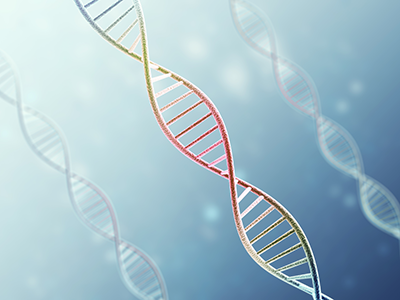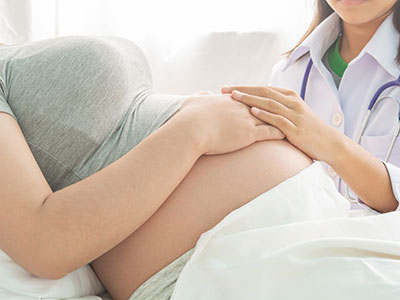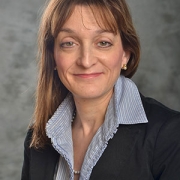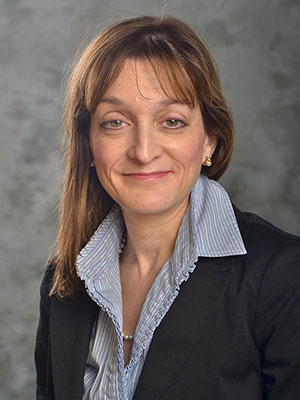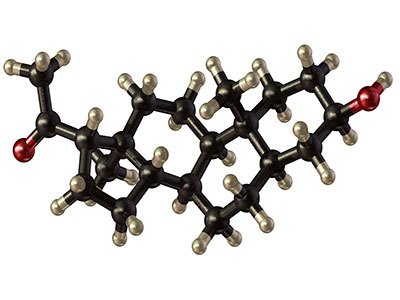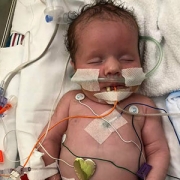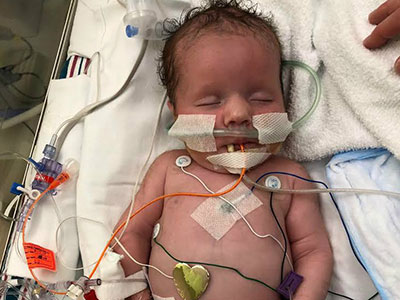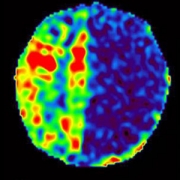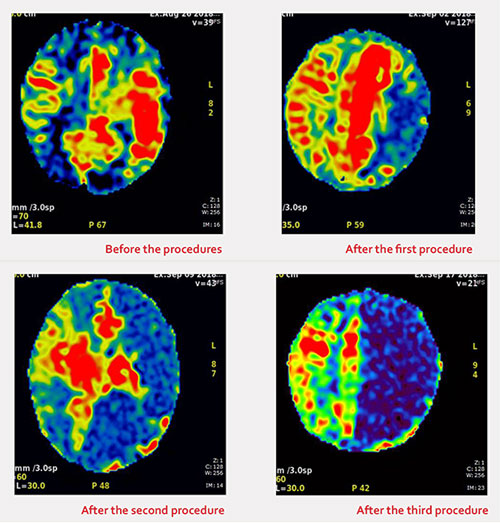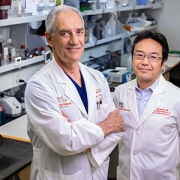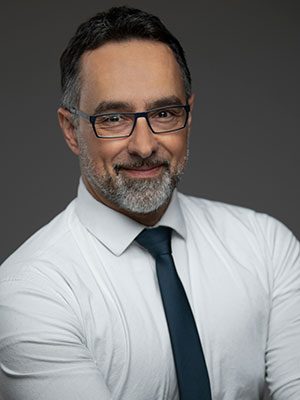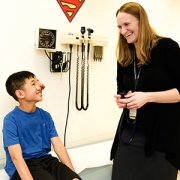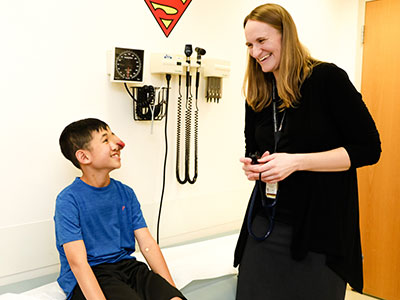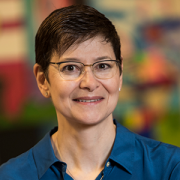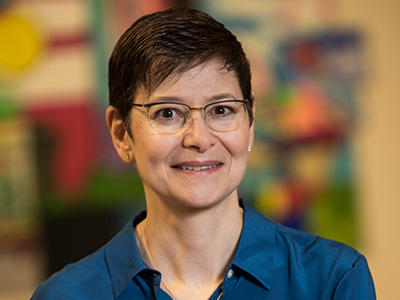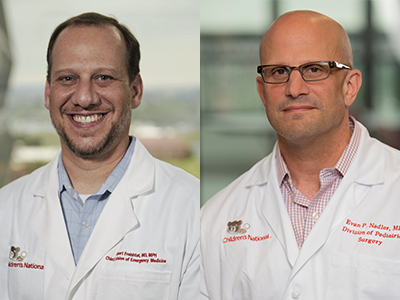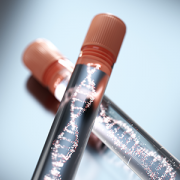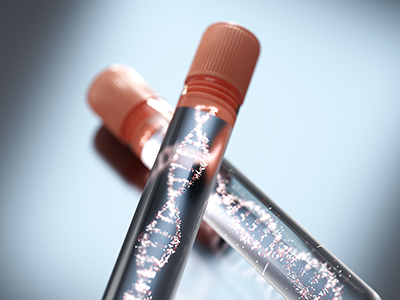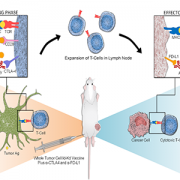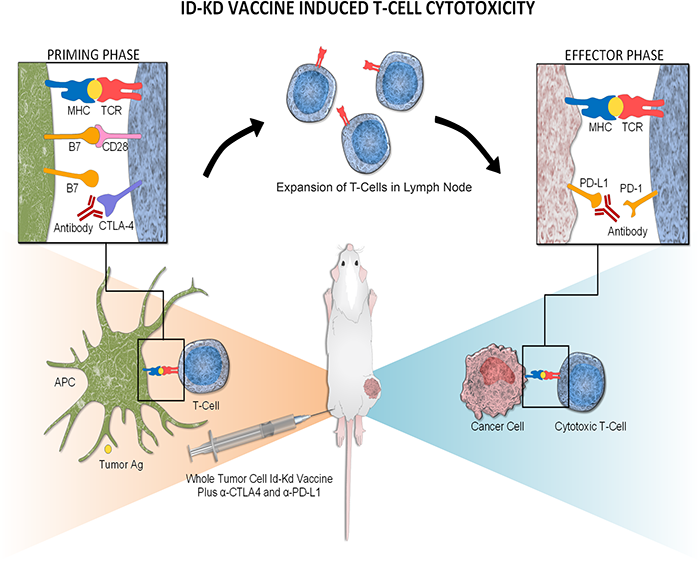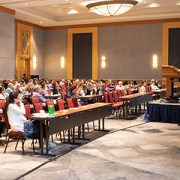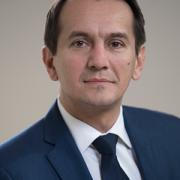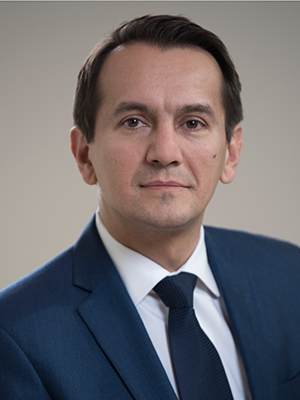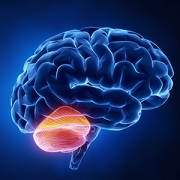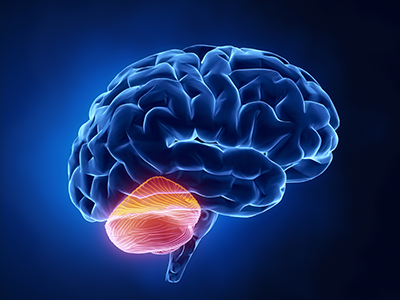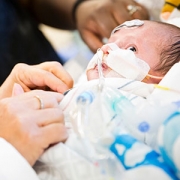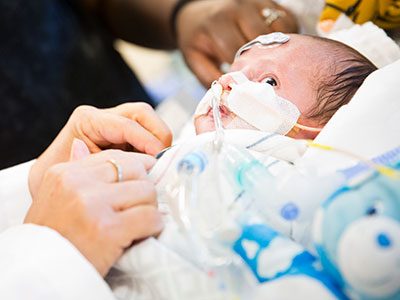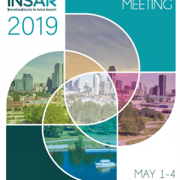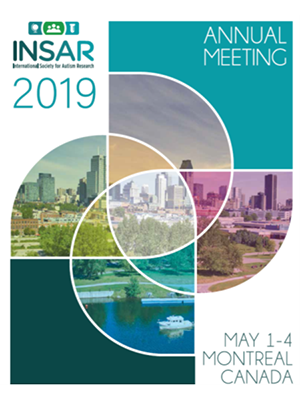
Natasha Shur, M.D., an attending clinical geneticist at Children’s National Health System, shares “Genetics and Telemedicine: Extending Our Reach” at the Future of Pediatrics CME symposium in Bethesda, Maryland, on June 20.
“For the first time it wasn’t autism, autism, autism,” Shannon Chin says after learning the reason her newborn daughter, Sariyah, who turned 3 in August, couldn’t feed like normal infants was due to a tiny deletion of chromosome 22. This atypical deletion, a variation of a genetic condition known as 22q11.2 deletion syndrome, left Sariyah unable to suck and obtain nourishment as an infant. She was born premature and relied on assisted feeding tubes, inserted through her nose, to help her grow.
At 22-weeks-old, Sariyah received the diagnosis, which affects 1 in 4,000 children born each year. Sariyah’s genetic tests encouraged Chin to follow up with a nagging question: What if her two sons, Rueben and Caleb, both of whom were diagnosed with autism spectrum disorder (ASD), had something else?
Debra Regier, M.D., a medical geneticist at Children’s National Health System, encouraged Chin to follow up with a genetic test to answer these questions and to confirm 22q11.2 deletion syndrome symptoms she observed in Rueben.
A microarray analysis recently revealed Rueben, 17, has atypical 22q11.2 deletion syndrome. Caleb, 5, took the test and has developmental delay and ASD, which is more likely to occur in children with 22q11.2 deletion syndrome. He tested negative for the same deletion as his siblings. Additional tests are underway.
As Chin juggles complex care for her children, she realizes the partial deletion of chromosome 22 presents differently in every child. Sariyah and Rueben share short stature; they fit into tiny clothes. That’s where the phenotypical clues stop. They don’t have a cleft palate or dysmorphic facial features, distinctive of typical cases of 22q11.2 deletion syndrome. Sariyah has physical symptoms. Her intestines merged together, which gastrointestinal surgery fixed. Rueben experiences behavioral and neurological symptoms, including picky eating, aggression and uncontrolled body movements, which led the Chin family to Dr. Regier. Sariyah, Rueben and Caleb all have neurodevelopmental delays that impact their speech and development.
Coordinating multiple visits with geneticists, specialists, surgeons, genetic counselors and pediatricians, while navigating insurance, is a lot for any parent, but especially for those, like Chin, who have special considerations. Her children are non-verbal, so she pays close attention to their physical cues. Simplifying this process is one reason why Natasha Shur, M.D., a medical geneticist at Children’s National, introduced virtual visits to her patients, including Rueben, who had challenges with in-person visits. She thought: How can we make medical care easier for patients and families?
In January, Dr. Shur expanded virtual visits into a pilot program for 50 to 60 patients, including Sariyah and Caleb, with the support of a grant from the Health Resources and Services Administration (HRSA), the division of telemedicine at Children’s National and the Rare Disease Institute (RDI), the medical home to thousands of pediatric patients living with rare or genetic conditions. This program lets patients with concern for or already diagnosed genetic conditions in Maryland, the District of Columbia and Virginia, where Dr. Shur is licensed to practice medicine, test out virtual visits. Patients can download the HIPAA-compliant app or click through a secure link on a digital device to connect with Dr. Shur or a pediatric subspecialist.
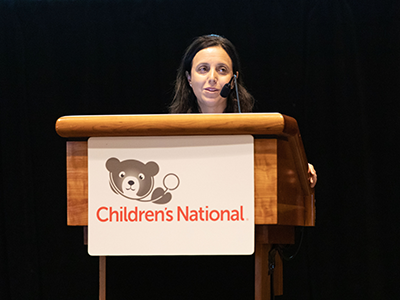
Dr. Shur shares the preliminary findings of a virtual visits pilot program, which 50-60 local patients have tested in conjunction with in-person visits as a flexible way to manage medical care for genetic conditions.
On June 20, Dr. Shur shared a presentation about the program, “Genetics and Telemedicine: Extending Our Reach,” with pediatricians attending the Children’s National Future of Pediatrics continuing medical education (CME) symposium in Bethesda, Maryland.
Instead of a formal pilot program launch and end date with data, Dr. Shur mentions she conducts quality improvement assessments with each patient. She asks what they like about virtual visits. Do they feel comfortable with the software and technology? What types of visits do they prefer to do at home? What works best at the hospital? Do they want to keep using this program?
For Chin and most participants, the answer is yes. These families appreciate saving time, mileage, and being in close access to pediatric subspecialists from the comfort of home.
Parents can conference call from separate locations and share screens with the doctors, which works well if one parent is at work and another is at home – or if they live apart. Children can maintain their normal routine, such as finishing breakfast, homework, playing or staying in bed if they don’t feel well, though it is important to see the child in the virtual visit.
Families can obtain virtual assessments about urgent conditions without taking time off from work or school. Currently, only 10 to 30% of virtual visit patients with concerns about genetic conditions need an in-person, follow-up appointment. Fortunately, many conditions are less urgent than thought at the time of referral. Dr. Shur and specialists also benefit from observing children in their natural environment.
At the symposium, Dr. Shur translates this into clinical terms: reduced no-show visits, the ability to schedule shorter, more flexible visits, the ability to quickly and accurately diagnose conditions and provide care, and the ability to keep children with compromised immune function out of public areas, including waiting rooms. She discussed building rapport with patients, almost all of whom like these flexible care models.
“The idea is that we’re trying to understand what is best done using virtual technology and what is better for those in-person connections. More detailed physical exams take place in person. There are some cases where eye-to-eye contact and sitting in the exam room together is important,” says Dr. Shur. “Virtual visits should never replace in-person care. It’s just a forward way of thinking about: How do we use our time best?”
Case study 1: Saving families time and miles
Dr. Shur notes that for some patients, distance is a deciding factor for scheduling care. One mother’s five-hour round-trip commute to the children’s hospital, without traffic, is now five minutes. As an air-traffic controller, her schedule changes. She values the flexibility of the new program. To connect with Dr. Shur, she logs into the app on her computer or smart phone and brings her 2-year-old son into the video. He has cardiofaciocutaneous syndrome (CFC), a condition that affects 200 to 300 people in the world. As a result of a MAP2K1 gene variant, one of four genes – BRAF, MAP2K1, MAP2K2 and KRAS – associated with CFC, he experiences feeding problems, reflux, constipation and developmental delays.
By scheduling more frequent, but shorter check-ins, Dr. Shur assesses how he responds to treatment and makes recommendations to the mother in real time, such as trying prune juice for digestive health. They talk about rearranging feeding measurements and intervals, including his 2 a.m. dose of a peptide formula, which the mom blends at home to support her son’s growth. This modification equates to more sleep for everyone.
If follow-up tests, such as an X-ray or a blood test are needed, Dr. Shur coordinates these exams with the family at the hospital or at a nearby medical center. Depending on the condition, Dr. Shur may refer the family to an ophthalmologist, cardiologist, neurologist or learning and development specialist.
As a parent, Dr. Shur appreciates the direct approach virtual visits deliver.
“As a mom, if I’m taking my child to the doctor for two hours, I want to know why I’m there,” Dr. Shur says. “What are all the options?”
Case study 2: Observing children at home
Chin, who was also featured in Dr. Shur’s CME presentation, appreciates virtual visits for their convenience and efficiency, but her favorite feature is letting doctors observe her children at home.
“Children act differently outside the home,” says Chin.
For example, instead of describing Rueben’s rapid, rhythmic arm movements, a flinging of the arms, Chin showed neurologists at a scheduled virtual home visit. For Marc DiFazio, M.D., a pediatric neurologist, it was evident that Reuben had a movement disorder commonly seen in children with ASD, which is responsive to medication. In five minutes, her son had a diagnosis. The involuntarily movement wasn’t a behavioral issue, as previously thought, but a movement disorder.
“The regular in-person visit has a beautiful role and it’s very important, but virtual visits bring a different focus,” says Dr. Shur. “We get to see what the child’s life is like, what the home setting is like and what their schedule is like. How can we make their day-to-day life easier?”
Phenylketonuria (PKU), a rare condition that prevents the body from breaking down phenylalanine (Phe), an amino acid in protein, is another condition that pairs well with virtual visits. PKU affects 1 in 10,000 to 15,000 newborns in the U.S. People with PKU often require medication, food-based formulas and a protein-restricted diet to help their body process or regulate Phe.
If a patient with PKU connects through a virtual visit, they (or their parents) can open the refrigerator, talk about low-protein foods, discuss potential barriers to following a low-Phe diet, show the team new supplements or over-the-counter medications they are taking, discuss reactions to new therapies and, for adults, discuss an injectable drug recently approved by the FDA that has side effects but may ultimately allow them to follow a regular diet. These observations may not warrant a traditional trip to the doctor but are important for geneticists and patients to discuss. The goal of these visits is to identify and work around potential health barriers, while preventing adverse health outcomes.
To support this model, a 60-minute in-person visit scheduled every six months to a year can be broken into 15-minute video appointments at more frequent intervals. The result, based on the same amount of clinical time, is a targeted and detailed assessment to support personalized treatment and to help the patient adapt to a low-Phe meal plan.
During the video call, Dr. Shur and the team may prescribe a different medication, order a diagnostic procedure or schedule a follow-up appointment, if necessary. Depending on the situation, the patient will still likely come in for in-person annual visits.
Program assessment: Evaluating visits for each patient
Despite the popularity of virtual visits, Dr. Shur mentions this program isn’t a good fit for everyone – depending on a patient’s preferences. There are also limitations to consider. If a parent is hesitant to try this platform or if the comprehensive physical examination is the first key step, they should schedule in-person visits. The goal is to give parents who are requesting or curious about virtual visits a chance to try the platform. Having a secure area, preferably a private space at home, is important. A Wi-Fi connection and a digital device are required, which may create barriers for some patients.
However, Dr. Shur finds the program can alleviate hurdles – such as transportation challenges. One patient lives two hours away and couldn’t make it in for routine medical visits due to car problems. Now she makes every virtual appointment. For the first time in her life, she can manage medical care for herself and for her children.
Most insurance companies Dr. Shur works with cover virtual visits. The key is to have the virtual connection, or video, so Dr. Shur can still physically see the patient. Otherwise, the visit doesn’t count. A grant from CareFirst covers the costs of visits for patients who are using Medicaid or who don’t have medical insurance.
Parallel trends are happening across the country and for other conditions. Officials at the Federal Communications Commission (FCC) are reviewing a three-year pilot to expand the use of connected care services, like virtual visits, for low-income Americans living in rural areas. The Rural Health Care Program, funded by the FCC, supports hospitals that implement telehealth programs.
The American Academy of Pediatrics (AAP) released a statement in 2015 about telemedicine technologies, noting that if these technologies are applied in a synergistic model under one health care system or are guided by a family doctor, they can transform pediatric health care.
The key is to avoid a fragmented virtual health system.
The AAP applauds virtual connections that support collaborations among pediatric physicians, subspecialists and surgeons, reduce travel burdens for families, alleviate physician shortages, improve the efficiency of health care and enhance the quality of care and quality of life for children with special health care needs.
Planning for the future, investing in physician-patient partnerships
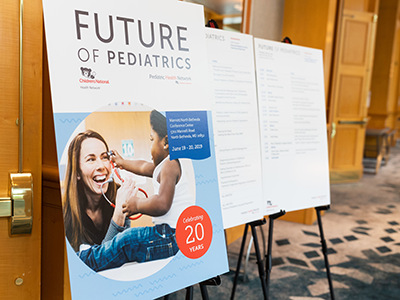
The American Academy of Pediatrics supports telemedicine technologies that enhance the quality of care and the quality of life for children with special health care needs.
“The feedback has been phenomenal,” Dr. Shur says about the future of virtual visits for genetics. “Virtual visits will never replace in-person visits. They will be used in conjunction with in-person visits to maximize care.”
Dr. Regier and Jamie Frasier, M.D., Ph.D., medical geneticists at Children’s National, are introducing virtual visits to their patients, and many providers plan to do so as the program expands.
Sarah Viall, PPCNP, a nurse practitioner and newborn screening specialist, works with Dr. Shur and the geneticists during some visits to explain non-urgent newborn screening results to parents through virtual connections. Some parents find it’s easier to dial in during lunch or while they are together at home.
To improve education for patients and families, the education and technology committees at the RDI – led by geneticists and genetic counselors in partnership with the Clinical and Translational Science Institute at Children’s National – launched a new smartphone app called BearGenes. Families can watch 15 videos about genetics on the pin-protected app or view them online. The interactive guide serves as a gene glossary for terms patients may hear in a clinical setting. Topics range from genetics 101, describing how DNA is encrypted in the body through four letters – A, T, C and G – to different types of genetic tests, such as whole exome sequencing, to look for differences in the spelling of genes, which the genetic counselors explain are genetic mutations.
“As we unite patients with virtual health platforms and new forms of technology, we want to see what works and what doesn’t. We want their feedback,” Dr. Shur reemphasizes. “Virtual visits are a dynamic process. These visits only work through patient partnership and feedback.”
As Chin navigates atypical 22q11.2 deletion syndrome and ASD, she continues to appreciate the virtual waiting room and the ease of access virtual visits provides.
Sharing screens during virtual visits enables Chin to examine and better understand her children’s abdomen and kidney sonograms, cardiology reports and hearing exams. It forces everyone in the visit to focus on one topic or image at a time, strengthening the connection.
Chin still has questions about her children’s DNA, but she’s getting close to having more answers. She’s eager to see Caleb’s genetic test results and to work with Hillary Porter, M.S., CGC, the family’s genetic counselor, to interpret the data.
“We’re all learning together,” Dr. Shur says about the new pilot program, which applies to genomics at large.
As research about 22q11.2 deletion syndrome advances, geneticists, pediatric subspecialists and pediatricians are unifying efforts to work as one diagnostic and treatment team. Virtual visits enable faster consultations and can shorten diagnostic odysseys, some of which may take up to five years for children with rare disorders.

Nearly 400 pediatricians attend the Children’s National Future of Pediatrics CME symposium to learn about the future of pediatrics and about ways to work together as a diagnostic and treatment team.
For Chin, by better understanding how a tiny fragment of a missing chromosome may influence her children’s growth and development, she is already making long-term plans and coordinating multidisciplinary medical treatment for each child.
She hopes that by sharing her story and knowledge about 22q11.2 deletion syndrome, she can help other parents navigate similar situations. Heradvice to parents is to follow up on lingering questions by bringing them up with your medical team.
Chin is optimistic and happy she did. She’s grateful for the virtual visits program, which simplifies complex care for her family. And she’s still waiting, but she hopes to learn more about her middle child’s DNA, unraveling another medical mystery.
Read more about the virtual visits pilot program at Becker’s Hospital Review and listen to an interview with Dr. Shur and Shannon Chin on WTOP.
